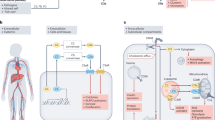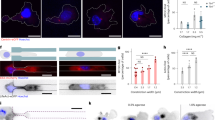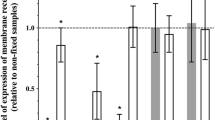Abstract
Studies on erythrocytes have shown that the formation of the membrane attack complex on a cell surface inevitably results in lysis. However, it is known that nucleated cells are much more difficult to kill with complement1–3, although the molecular basis of this resistance has never been established. We have shown that a very early intracellular event, occurring within seconds of formation of the attack complex in the membrane, is a rise in cytoplasmic Ca2+ (ref. 4), which can activate cell responses without cell death5,6. Here we report the use of a monoclonal antibody to the terminal complement component C9 (refs 7, 8, 13), quantified by 125I and visualized by fluorescein, to demonstrate a protection mechanism in polymorphonuclear leukocytes (PMNs) attacked by complement, involving removal of the attack complex by vesiculation. Concomitantly, there is a Ca2+-dependent activation of reactive oxygen metabolite production without cell lysis. These findings have important implications in the evolutionary and pathological significance of the terminal components of the complement pathway.
This is a preview of subscription content, access via your institution
Access options
Subscribe to this journal
Receive 51 print issues and online access
$199.00 per year
only $3.90 per issue
Buy this article
- Purchase on SpringerLink
- Instant access to full article PDF
Prices may be subject to local taxes which are calculated during checkout
Similar content being viewed by others
References
Boyle, M. D. P., Ohanian, S. H. & Borsos, T. J. J. Immun. 116, 1276–1279 (1976).
Ohanian, S. H. & Schlager, S. I. CRC crit. Rev. Immun. 1, 165–209 (1981).
Sissons, J. G. & Oldstone, M. B. A. Adv. Immun. 29, 209–260 (1980).
Campbell, A. K., Daw, R. A. & Luzio, J. P. FEBS Lett. 107, 55–60 (1979).
Hallett, M. B., Luzio, J. P. & Campbell, A. K. Immunology 44, 569–577 (1981).
Campbell, A. K. & Luzio, J. P. Experientia 37, 1110–1112 (1981).
Morgan, B. P., Daw, R. A., Siddle, K., Luzio, J. P. & Campbell, A. K. J. Immun. Meth. 84, 269–281 (1983).
Morgan, B. P., Campbell, A. K., Luzio, J. P. & Siddle, K. Clin. chim. Acta 134, 85–94 (1983).
Hallett, M. B. & Campbell, A. K. Nature 259, 155–157 (1982).
Morgan, B. P., Sewry, C. A., Siddle, K., Luzio, J. P. & Campbell, A. K. Immunology 52, 181–188 (1984).
Koski, C. L., Ramm, L. E., Hammer, C. H., Mayer, M. M. & Shin, M. L. Proc. natn. Acad. Sci. U.S.A. 80, 3816–3820 (1983).
Ramm, L. E., Whitlow, M. B., Koski, C. L., Shin, M. L. & Mayer, M. M. J. Immun. 131, 1411–1415 (1983).
Morgan, B. P., Luzio, J. P. & Campbell, A. K. Biochem. biophys. Res. Commun. 118, 616–622 (1984).
Campbell, A. K., Holt, M. & Patel, A. Recent Adv. clin. Biochem. 3, 1–30 (1985).
Hallett, M. B. & Campbell, A. K. Biochem. J. 216, 459–465 (1983).
Biesecker, G. Lab. Invest. 49, 237–250 (1983).
Esser, A. F. in Biological Membranes Vol. 4 (ed. Chapman, D.) 276–325 (Academic, New York, 1982).
Lachmann, P. J. Nature 305, 473–474 (1983).
Campbell, A. K. Intracellular Calcium: Its Universal Role as Regulator (Wiley, Chichester, 1983).
Edwards, S. W., Morgan, B. P., Hoy, T. G., Luzio, J. P. & Campbell, A. K. Biochem. J. 206, 195–202 (1983).
Roberts, P. A., Morgan, B. P. & Campbell, A. K. Biochem. biophys. Res. Commun. 126, 692–697 (1985).
Richardson, P. J. & Luzio, J. P. Biochem. J. 186, 897–906 (1980).
Imagawa, D. K., Osifchin, N. E., Paznekas, W. A., Shin, M. L. & Mayer, M. M. Proc. natn. Acad. Sci. U.S.A. 80, 6647–6651 (1983).
Morgan, B. P., Campbell, A. K. & Compston, A. Lancet ii, 251–255 (1984).
Joiner, K. et al. Fedn Proc. 44, 552 (1985).
Campbell, A. K. & Hallett, M. B. J. Physiol., Lond. 338, 537–550 (1983).
Author information
Authors and Affiliations
Rights and permissions
About this article
Cite this article
Campbell, A., Morgan, B. Monoclonal antibodies demonstrate protection of polymorphonuclear leukocytes against complement attack. Nature 317, 164–166 (1985). https://doi.org/10.1038/317164a0
Received:
Accepted:
Issue date:
DOI: https://doi.org/10.1038/317164a0
This article is cited by
-
Cell-Cell Communication Via Extracellular Membrane Vesicles and Its Role in the Immune Response
Molecules and Cells (2013)
-
Ectosomes as immunomodulators
Seminars in Immunopathology (2011)
-
Emission of membrane vesicles: roles in complement resistance, immunity and cancer
Springer Seminars in Immunopathology (2005)
-
Membrane signaling by complement C5b-9, the membrane attack complex
Immunologic Research (1993)
-
Local complement activation in inflammatory bowel disease
Immunologic Research (1991)



